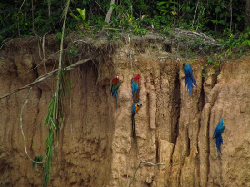Descripción de la Familia Psittacidae que habita la Reserva Nacional de Tambopata, Perú
DOI:
https://doi.org/10.51252/reacae.v2i2.520Palabras clave:
Amazonía, aves, hábitat, psitaciformes, selva tropicalResumen
La familia Psittacidae enfrenta riesgo de extinción debido a la destrucción del hábitat y el comercio ilegal. Este estudio buscó registrar las especies de psitácidos en la Reserva Nacional de Tambopata y discutir su conservación. Se realizó un muestreo en transectos, caminando y registrando visualmente las especies cada kilómetro. Se identificaron 16 especies de psitácidos en 12 géneros, incluyendo guacamayos, loros, pericos y periquitos. De estas especies, 10 se encuentran en preocupación menor (LC), 2 en casi amenazada (NT) y 1 especie (Primolius couloni) como vulnerable. Pionus menstruus y Amazona ochrocephala aún no han sido evaluadas por la IUCN. Estos resultados demuestran la existencia de especies de Psitaciformes en peligro en Madre de Dios, Perú.
Descargas
Citas
Alvarez-Berríos, N. L., & Mitchell Aide, T. (2015). Global demand for gold is another threat for tropical forests. Environmental Research Letters, 10(1), 014006. https://doi.org/10.1088/1748-9326/10/1/014006
Asner, G. P., & Tupayachi, R. (2016). Accelerated losses of protected forests from gold mining in the Peruvian Amazon. Environmental Research Letters, 12(9), 094004. https://doi.org/10.1088/1748-9326/aa7dab
Atyeo, W. T. (1989). Aralichus porrectus (Mégnin & Trouessart) and related feather mite species (Acarina, Pterolichidae) from parrots of the genus Brotogeris Vigors (Aves, Psittacidae). Systematic Parasitology, 14(2), 101–111. https://doi.org/10.1007/BF00016904
Berkunsky, I., Cepeda, R. E., Marinelli, C., Simoy, M. V., Daniele, G., Kacoliris, F. P., Díaz Luque, J. A., Gandoy, F., Aramburú, R. M., & Gilardi, J. D. (2016). Occupancy and abundance of large macaws in the Beni savannahs, Bolivia. Oryx, 50(1), 113–120. https://doi.org/10.1017/S0030605314000258
Brightsmith, D. (2004). Effects of Diet, Migration, and Breeding on Clay Lick Use by Parrots in Southeastern Peru [Universidad de Duke]. http://macaw.pbworks.com/f/Brightsmith2004.pdf
Brightsmith, D. J. (2004). Effects of Weather on Parrot Geophagy in. Wilson Bulletin, 116(2), 1–12.
Brightsmith, D. J. (2005). Parrot nesting in southeastern peru: seasonal patterns and keystone trees. The Wilson Bulletin, 117(3), 296–305. https://doi.org/10.1676/03-087A.1
Brightsmith, D. J., Hobson, E. A., & Martinez, G. (2018). Food availability and breeding season as predictors of geophagy in Amazonian parrots. Ibis, 160(1), 112–129. https://doi.org/10.1111/ibi.12515
Daut, E. F., Brightsmith, D. J., Mendoza, A. P., Puhakka, L., & Peterson, M. J. (2015). Illegal domestic bird trade and the role of export quotas in Peru. Journal for Nature Conservation, 27, 44–53. https://doi.org/10.1016/j.jnc.2015.06.005
Jan, C., & Fumagalli, L. (2016). Polymorphic DNA microsatellite markers for forensic individual identification and parentage analyses of seven threatened species of parrots (family Psittacidae). PeerJ, 4, e2416. https://doi.org/10.7717/peerj.2416
Lane, D., Stotz, D., O’Neill, J., Parker III, T., & Schulenberg, T. (2010). Aves de Perú (1st ed.). Centro de Ornitología y Biodiversidad.
Ludeña, B., & Pintaud, J. C. (2017). Sexaje molecular en Psitacidae. Revista Ecuatoriana de Medicina y Ciencias Biológicas, 28(1–2), 23–29. https://doi.org/10.26807/remcb.v28i1-2.199
Monterrubio-Rico, T. C., Charre-Medellín, J. F., Pacheco-Figueroa, C., Arriaga-Weiss, S., Valdez-Leal, J. de D., Cancino-Murillo, R., Escalona-Segura, G., Bonilla-Ruz, C., & Rubio-Rocha, Y. (2016). Distribución potencial histórica y contemporánea de la familia Psittacidae en México. Revista Mexicana de Biodiversidad, 87(3), 1103–1117. https://doi.org/10.1016/j.rmb.2016.06.004
Olah, G., Butchart, S. H. M., Symes, A., Guzmán, I. M., Cunningham, R., Brightsmith, D. J., & Heinsohn, R. (2016). Ecological and socio-economic factors affecting extinction risk in parrots. Biodiversity and Conservation, 25(2), 205–223. https://doi.org/10.1007/s10531-015-1036-z
Ribas, C. C., Gaban-Lima, R., Miyaki, C. Y., & Cracraft, J. (2005). Historical biogeography and diversification within the Neotropical parrot genus Pionopsitta (Aves: Psittacidae). Journal of Biogeography, 32(8), 1409–1427. https://doi.org/10.1111/j.1365-2699.2005.01289.x
Trivedi, M. R., Cornejo, F. H., & Watkinson, A. R. (2004). Seed Predation on Brazil Nuts (Bertholletia excelsa) by Macaws (Psittacidae) in Madre de Dios, Peru. Biotropica, 36(1), 118–122. https://doi.org/10.1111/j.1744-7429.2004.tb00302.x
Ureta Adrianzén, M., Martínez Gonzales, P., Tupayachi Trujillo, R., & Zúñiga Hartley, A. (2014). Fenología de palmeras arborescentes nativas de Madre De Dios – Perú. Intropica, 9, 60. https://doi.org/10.21676/23897864.1425
Vigo, G., Williams, M., & Brightsmith, D. J. (2011). Growth of scarlet macaw (Ara macao) chicks in South Eastern Peru. Ornitologia Neotropical, 22(1), 143–153. https://www.academia.edu/24370774/GROWTH_OF_SCARLET_MACAW_ARA_MACAO_CHICKS_IN_SOUTHEASTERN_PERU

Publicado
Cómo citar
Número
Sección
Licencia
Derechos de autor 2023 Gustavo Martínez-Sovero, Sebastian Iglesias-Osores

Esta obra está bajo una licencia internacional Creative Commons Atribución 4.0.
Los autores retienen sus derechos:
a. Los autores retienen sus derechos de marca y patente, y tambien sobre cualquier proceso o procedimiento descrito en el artículo.
b. Los autores retienen el derecho de compartir, copiar, distribuir, ejecutar y comunicar públicamente el articulo publicado en la Revista Amazónica de Ciencias Ambientales y Ecológicas (REACAE) (por ejemplo, colocarlo en un repositorio institucional o publicarlo en un libro), con un reconocimiento de su publicación inicial en la REACAE.
c. Los autores retienen el derecho a hacer una posterior publicación de su trabajo, de utilizar el artículo o cualquier parte de aquel (por ejemplo: una compilación de sus trabajos, notas para conferencias, tesis, o para un libro), siempre que indiquen la fuente de publicación (autores del trabajo, revista, volumen, número y fecha).



